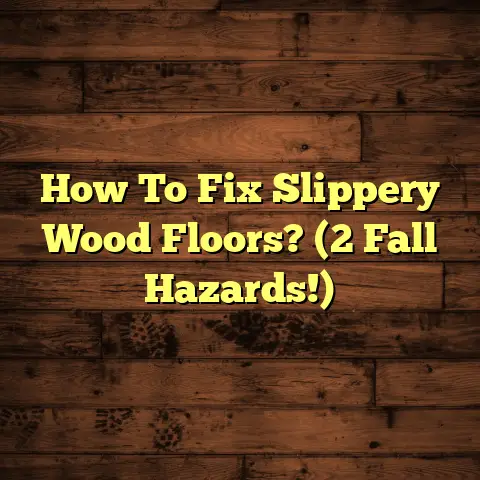Hardwood Flooring: Cost Per Foot? (2 Price Factors!)
Think about it: a dark, rich walnut in the living room flowing into a lighter, airier maple in the hallway. Or maybe a rustic, hand-scraped oak in the dining room meeting a sleek, modern bamboo in the kitchen.
It’s like creating a visual tapestry underfoot!
Blending different colors, textures, and even species can add so much personality and depth to your home. But before you get too carried away with your design dreams, let’s talk about the elephant in the room: the cost.
Combining different hardwoods can definitely impact the overall price of your flooring project. You’re dealing with potentially different material costs, installation considerations, and even maintenance needs.
So, in this article, we’re going to break down the nitty-gritty of hardwood flooring costs, specifically focusing on the price per foot. I’ll walk you through the key factors that influence that price, and how blending styles can play into the equation. Ready? Let’s dive in!
Section 1: Understanding Hardwood Flooring Costs
Hardwood flooring. It’s a classic for a reason! It adds warmth, elegance, and value to any home. I mean, who doesn’t love the feel of real wood under their feet?
But let’s be real, it’s not always the cheapest option. That’s where understanding the cost per foot comes in.
Think of cost per foot as the standard unit of measurement in the hardwood world. It’s how contractors like myself give you estimates, and how you can compare prices between different options.
Basically, it’s the price you pay for one square foot of the installed flooring.
Now, what goes into that price? A lot, actually. Here’s a quick rundown of the main players:
- Species: Oak? Maple? Hickory? Exotic Brazilian Cherry? The type of wood makes a huge difference.
- Grade: This refers to the quality and appearance of the wood. Think knots, grain patterns, and color variations.
- Finish: Pre-finished or unfinished? The type of finish and the number of coats will affect the price.
- Installation: Are we talking nail-down, glue-down, or floating? And what about subfloor prep?
- Location: Believe it or not, where you live can impact the price of hardwood.
Speaking of location, regional variations in pricing are a real thing. Market demand, local labor costs, and even transportation costs can all play a role.
For example, I’ve seen the same type of oak flooring cost significantly more in California compared to, say, Tennessee. It’s all about supply and demand!
Here is a table showing the average cost per square foot of different types of hardwood in different states:
| Type of Hardwood | Cost Per Square Foot (California) | Cost Per Square Foot (Tennessee) |
|---|---|---|
| Oak | \$8 – \$15 | \$6 – \$12 |
| Maple | \$9 – \$16 | \$7 – \$13 |
| Hickory | \$10 – \$18 | \$8 – \$15 |
Please note that these are average ranges and can vary based on the specific grade, finish, and installation method.
Section 2: Price Factor 1 – Type of Hardwood
Alright, let’s get into the meat of it: the type of hardwood. This is a HUGE factor in determining the cost per foot.
You’ve got your classic options like oak, maple, cherry, and hickory. And then you’ve got your more exotic choices like Brazilian Walnut (Ipe), teak, and bamboo.
Here’s a quick rundown of some popular hardwood species and their approximate cost ranges per foot (materials only, installation not included):
- Oak: \$3 – \$8 per square foot. A classic for a reason! Durable and readily available.
- Maple: \$4 – \$9 per square foot. Known for its smooth grain and lighter color.
- Hickory: \$5 – \$10 per square foot. Super durable and has a rustic, character-rich look.
- Cherry: \$6 – \$12 per square foot. Rich, reddish-brown color that deepens over time.
- Brazilian Walnut (Ipe): \$8 – \$15 per square foot. Very dense, durable, and water-resistant.
- Bamboo: \$6 – \$11 per square foot. Technically a grass, but it’s a sustainable and stylish option.
Why the big price differences? Rarity and sourcing play a big role. Some species are simply more difficult to come by, which drives up the price.
Think about it: a rare, slow-growing hardwood harvested from a remote location is going to cost more than a common, fast-growing hardwood sourced locally.
And then there’s the whole solid vs. engineered hardwood debate.
Solid hardwood is exactly what it sounds like: planks made from a single piece of wood. It’s beautiful, durable, and can be refinished multiple times. But it’s also more susceptible to moisture and temperature changes, and it’s generally more expensive.
Engineered hardwood, on the other hand, is made up of multiple layers of wood veneer bonded together. It’s more stable than solid hardwood, making it a better choice for basements or areas with high humidity. It’s also generally more affordable.
Here’s a table comparing solid and engineered hardwood costs:
| Type of Hardwood | Average Cost Per Square Foot (Materials Only) |
|---|---|
| Solid Hardwood | \$5 – \$15+ |
| Engineered Hardwood | \$3 – \$10 |
These are approximate ranges. Actual costs may vary.
Now, let’s talk about sustainability. Choosing sustainably harvested hardwoods is not only good for the environment, but it can also impact the cost. Look for certifications like FSC (Forest Stewardship Council) or SFI (Sustainable Forestry Initiative).
These certifications ensure that the wood comes from responsibly managed forests. Sustainable options may sometimes be a bit pricier upfront, but they’re worth it in the long run.
Finally, don’t forget about durability and maintenance. A harder, more durable wood might cost more upfront, but it will likely last longer and require less maintenance, saving you money in the long run.
For instance, hickory is one of the hardest domestic hardwoods, making it a great choice for high-traffic areas. So, while it might cost a bit more than oak, it could be a smarter investment overall.
Section 3: Price Factor 2 – Installation and Labor Costs
Okay, we’ve covered the material costs. Now, let’s talk about the second big price factor: installation and labor.
This is where things can get a little tricky, as costs can vary widely depending on the installation method, the complexity of the job, and your location.
First, let’s talk about installation methods. The three main options are:
- Nail-Down: This is the traditional method, where the hardwood planks are nailed directly to the subfloor. It’s best for solid hardwood and requires a wood subfloor.
- Glue-Down: As the name suggests, the planks are glued to the subfloor. This method is often used for engineered hardwood and can be installed over concrete.
- Floating: The planks are clicked together and “float” over the subfloor. This is a popular choice for engineered hardwood and is often the easiest and most affordable option.
Each method has its own pros and cons, and the cost will vary accordingly. Nail-down and glue-down installations typically require more labor and expertise, so they tend to be more expensive.
Here’s a rough estimate of installation costs per square foot:
| Installation Method | Average Cost Per Square Foot (Labor Only) |
|---|---|
| Nail-Down | \$3 – \$6 |
| Glue-Down | \$4 – \$7 |
| Floating | \$2 – \$5 |
Now, should you hire a professional installer or DIY? That’s a big question. While DIYing can save you money upfront, it’s not always the best idea.
Installing hardwood flooring is a skill, and if you don’t do it right, you could end up with costly mistakes.
Trust me, I’ve seen it happen! Uneven floors, gaps between planks, and squeaky spots are just a few of the potential problems.
Hiring a professional installer ensures that the job is done right the first time. They have the experience, tools, and knowledge to handle any challenges that may arise.
Of course, professional installation comes at a cost. Labor rates can vary depending on your location and the complexity of the job.
But in my opinion, it’s usually worth the investment. You’re paying for peace of mind and a flawless finished product.
Another often-overlooked cost is subfloor preparation. Your subfloor needs to be clean, level, and dry before you can install hardwood flooring.
If your subfloor is in bad shape, you may need to repair or replace it, which can add to the overall cost.
For example, if you have a concrete subfloor with cracks or uneven spots, you may need to apply a self-leveling compound to create a smooth surface.
This can add anywhere from \$1 to \$3 per square foot to the total cost.
Finally, let’s talk about regional differences in labor costs. Just like material costs, labor rates can vary depending on where you live.
In general, labor costs are higher in urban areas and on the coasts. This is due to a higher cost of living and greater demand for skilled tradespeople.
To illustrate the variations in pricing, let’s look at a couple of case studies:
- Case Study 1: Simple Oak Installation in a 200 sq ft Bedroom (Tennessee)
- Materials (Oak): \$600 (\$3 per sq ft)
- Installation (Floating): \$500 (\$2.50 per sq ft)
- Total: \$1100
- Case Study 2: Complex Hickory Installation in a 400 sq ft Living Room (California)
- Materials (Hickory): \$3200 (\$8 per sq ft)
- Subfloor Prep: \$600 (\$1.50 per sq ft)
- Installation (Nail-Down): \$2000 (\$5 per sq ft)
- Total: \$5800
These are just examples, of course. But they illustrate how different factors can impact the overall cost of your hardwood flooring project.
Section 4: Final Thoughts on Cost Analysis
Okay, we’ve covered a lot of ground! Let’s recap the key takeaways regarding hardwood flooring costs per foot.
First, remember that the type of hardwood is a major price driver. Rare, exotic species will cost more than common, domestic options.
Second, installation and labor costs can also significantly impact the overall price. The installation method, the complexity of the job, and your location all play a role.
Understanding these cost components is crucial for making informed decisions. Don’t just focus on the material cost. Consider the installation costs, the long-term durability, and the maintenance requirements.
And what about blending styles? Well, that can add another layer of complexity to the cost analysis.
If you’re mixing different species, you’ll need to factor in the price differences between them. You may also need to consider different installation methods or maintenance requirements.
But don’t let the cost deter you from blending styles! The visual impact can be well worth the extra effort and expense.
Think about it: a carefully curated mix of hardwoods can create a truly unique and stunning look that reflects your personal style.
In the long run, investing in quality hardwood flooring is almost always the better choice. Cheaper alternatives may save you money upfront, but they often lack the durability and aesthetic appeal of real hardwood.
Plus, hardwood flooring can increase the value of your home, making it a smart investment in the long run.
Conclusion
So, there you have it: a comprehensive guide to understanding the cost per foot of hardwood flooring.
Remember, the type of hardwood and the installation and labor costs are the two primary factors influencing the price.
Blending styles can add another dimension to the equation, but it can also create a truly unique and personalized look.
Ultimately, the best flooring choice is the one that reflects your style preferences, fits your budget, and enhances your living space.
Don’t be afraid to explore different options, ask questions, and get multiple quotes from contractors.
And most importantly, choose a flooring that you’ll love for years to come!





